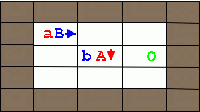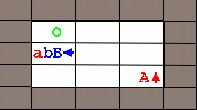The first slideshow is a long one, being the First Moment Experiment from
chapter 6 of John Andreae's Associative Learning for a Robot Intelligence.
The experiment is based on a paradigmatic experiment described by Elizabeth
Bates in her The Emergence of Symbols, Academic Press, 1979. It is
concerned with the behaviour of a 9-month old infant and its carer. PURR-PUSS
takes the place of the infant and has four reflexes: Reflex-1 is to cry if its
frustration parameter exceeds a threshold; reflex-2 is to look towards a sound
or movement; reflex-3 is to grab at a toy-sized object if one appears; reflex-4
is to drop a grasped toy. The first 5 of PURR-PUSS's (PP's) actions are by
reflex as well as 6 of the remaining 49. All other actions were selected by PP.
It is argued that this sequence (just) satisfies Bates' definition of
intentional communication as signalling behavior in which the sender is aware
a priori of the effect that a signal will have on his listener, and he persists
in that behavior until the effect is obtained or failure is clearly indicated.
The second two slideshows given below are of plans made during experiments in
2001 with two robots, A and B, in the Squash-Pop Microworld. Robot A has a
PURR-PUSS brain.
Robot B's relationship with robot A is intended to be like a mother and infant,
with robot B as the mother and robot A as the infant. It is a fairly old idea
in psychology that mother (B) sets up goals for the infant (A) to achieve,
helps the infant to achieve them, and they then end up as goals of the infant.
We can program robot B to act like a mother or carer.
With robot B obeying its programs, robot A learns to control robot B by using
Sounds learned from robot B, and it also learns to respond to robot B's use of
these Sounds to get a GOOD reward from robot B.
It is essential to remember that robot A, which has the PURR-PUSS brain, starts
with no understanding of the symbols A, B, O, Q, Forward, Left, Right, etc.
These are meaningful to us but not to PURR-PUSS. Any of them can be exchanged at
the start for symbols that are meaningless to us as well as to it, but that would
make it difficult for us to keep track of what was happening.
Robot B is programmed to make sounds corresponding to its actions, unless it is
hearing sounds in which case it carries out the actions corresponding to the
sounds. Robot A starts without any knowledge of any connection between sounds
and actions, but learns to control robot B with sounds. This can be seen in the
plans it makes. Two of those plans are given in the slideshows.
There is a weak sense in which PURR-PUSS becomes aware of both itself and robot B
because it can see robot B and itself with its eye and can feel the other robot
with its touch sense. PURR-PUSS's plans record its own and robot B's movements
and the influence of its Sounds on those movements. Nevertheless, this is a
long way from the kind of awareness and consciousness that we have. PURR-PUSS
does not know anything about the symbols and their meaning. It has only learned
simple functional relationships between them.

|
This slideshow gives the sequence of steps in the First
Moment Experiment of chapter 6 in Associative Learning for a Robot
Intelligence. Please click on picture at the left.
|

|
This slideshow gives the sequence of steps in a plan made by
PURR-PUSS in the Squash-Pop Microworld. The plan was reported in the paper
ANNES2001World.doc and it may be downloaded from the Papers section. Please
click on picture at the left.
|

|
This slideshow gives the sequence of steps in a plan made by
PURR-PUSS in the Squash-Pop Microworld. The plan was reported in the paper
ANNES2001Talk.doc and it may be downloaded from the Papers section. Please
click on picture at the left.
|
|



